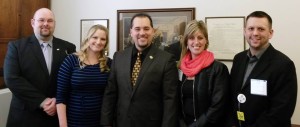If there’s a word Rep. Eric Lucero can use to sum up his first month at the State Capitol building in St. Paul, it’s this – patience.
“We’ve been very much in the information gathering stages,” Lucero said about two weeks ago during a conversation with North Wright County Today at Sadie’s Coffee in St. Michael. “With the [governor’s] budget out now and some other things moving ahead, things will start to get faster. It will be all about putting past budgets up against future requests, and seeing how to best move ahead.”
The 2015 session – minus some of the usual partisan spats and some in-party infighting – has been pretty lackluster so far. Legislators still have several weeks to hammer out budgets for the next biennium (two years) for everything from social services to education and transportation, so many hearings and amendments are just getting tossed into the mix.
For a rookie legislator like Lucero, whose targets are two of the biggest one can pick – transportation and education, the first month has been all about patience. And potential.
“The [Republican] House caucus is very much holding to the policy that we can move forward with no tax increases. As has been the case with Gov. Dayton, that’s where we differ the most. He’s proposed several tax increases to tackle transportation. Our belief is that the state doesn’t have a revenue problem, it has a spending problem. So it remains to be seen where we can find how to move ahead without tax revenue and how to spend more wisely,” Lucero said.
Targeting Interstate 94 through Albertville
Lucero’s biggest transportation bullet point is the continued expansion of Interstate 94 to six lanes through his district, 30B, which ends at the western border of Albertville. The state’s Corridor’s of Commerce project list includes both the funds to expand through Highway 241 in St. Michael (already under construction) and a study to see how to widen the roadway to at least the County Road 37 exit in Albertville.
Lucero would like to see the expansion planned for up to at least County Road 19 for the next biennium.

Rep. Eric Lucero poses with St. Michael council members Chris Schumm, Nadine Schoen and Cody Gulick, as well as Albertville Mayor Jillian Hendrickson (to his left) at the State Capitol. (Eric Lucero)
“The ultimate goal is to get it to St. Cloud, of course,” he said. “That’s what is going to help residents here and, especially, business owners here the most. Every minute a truck spends sitting on 94 is lost money for that business owner. So it’s an investment that brings return to our local businesses.”
Lucero also pointed to public transportation projects, such as the Southwest LRT (light rail), as possible drains on funds that could be appropriated to widening the highway.
“I feel good about the potential. We’re changing that focus from transit to roads and bridges, and that’s what needs to happen,” he said, pointing to his seat on the transportation policy and finance committee.
As for costs, Lucero said the answer isn’t as simple as the governor’s plan to raise gas taxes (impacting what you pay at the pump). With higher mileage – and even electric – vehicles on the road, gas taxes aren’t practical for raising more revenue long term.
“You’re going to create, eventually, a gap, between what you forecast and what you’re actually able to collect,” he said. “So it’s something we’re looking at very hard in the transportation committee.”
Lucero was part of “transportation day” at the capitol last week, which included visits from several St. Michael and Albertville elected officials.
Changing Education Funding Little by Little
Lucero campaigned on the promise of more equitable funding for school districts such as St. Michael-Albertville and Buffalo-Hanover-Montrose, and has already authored two bills to chip away at the inequities facing those districts.
House File 175 and the recently filed H.F. 983, submitted by Lucero on President’s Day, both tackle some of that inequity. STMA Superintendent James Behle said the proposals will add to the district’s bottom line, but won’t help with the huge gap facing schools in 2016.
“It’s not going to be a big change,” Lucero said of the education gap that exists between big, property-wealthy districts vs. exurban or even rural districts. “It’s going to take a concerted, multi-year effort to change some of the policies that have been here for a long time. That change took decades, so it’s going to take a while to change a formula that is very long and very complex.”
Lucero’s two bills deal with that equity gap, and with a possible formula to help with “aid disparity.”
“A lot of the gap is created by the programs that fall out of the general education category,” said Dr. James Behle, superintendent of STMA schools. “So the disparity comes in a district like STMA because we don’t have a lot of students who are in that category of needing food program assistance or Title I. We’re fortunate in that sense, but it’s unfortunate that it creates this funding gap in state aid.”
Lucero said other districts, both within his Legislative District and from throughout the state, are seeing this issue continue to raise its ugly head.
“You have a groundswell of support for this kind of change because there are many districts operating under that state average,” he said. “So the first objective is to bring everyone up, closer to that average.”